Market development of Vietnam’s performing arts in Asean region from the perspective of regional integration
When it comes to the performing arts of Vietnam, it is popular
to think of types of arts which have become a part of the cultural and
spiritual life of Vietnamese people such as Ca Tru (a complex form
of sung poetry), Cheo (Vietnamese traditional opera), Boi singing (a
Vietnamese operatic art form), Bai Choi singing (a folklore style of
singing), Don ca tai tu music and song, Cai Luong (modern folk
opera), Puppetry, Circus, etc. From the perspective of cultural
economy, these types of arts are fully potential to become typical
cultural products, with many competitive advantages in the overall
national cultural industry. Therefore, developing the market for
various types of performing arts in Vietnam is a story that needs to
be discussed specifically and comprehensively. Within the scope of
this paper, the author discusses the issue of market development of
Vietnamese performing arts beyond the national territory,
penetrating ASEAN market and the world market from considering
the current ASEAN regional integration, which is a valuable
opportunity that stakeholders need to exploit effectively.
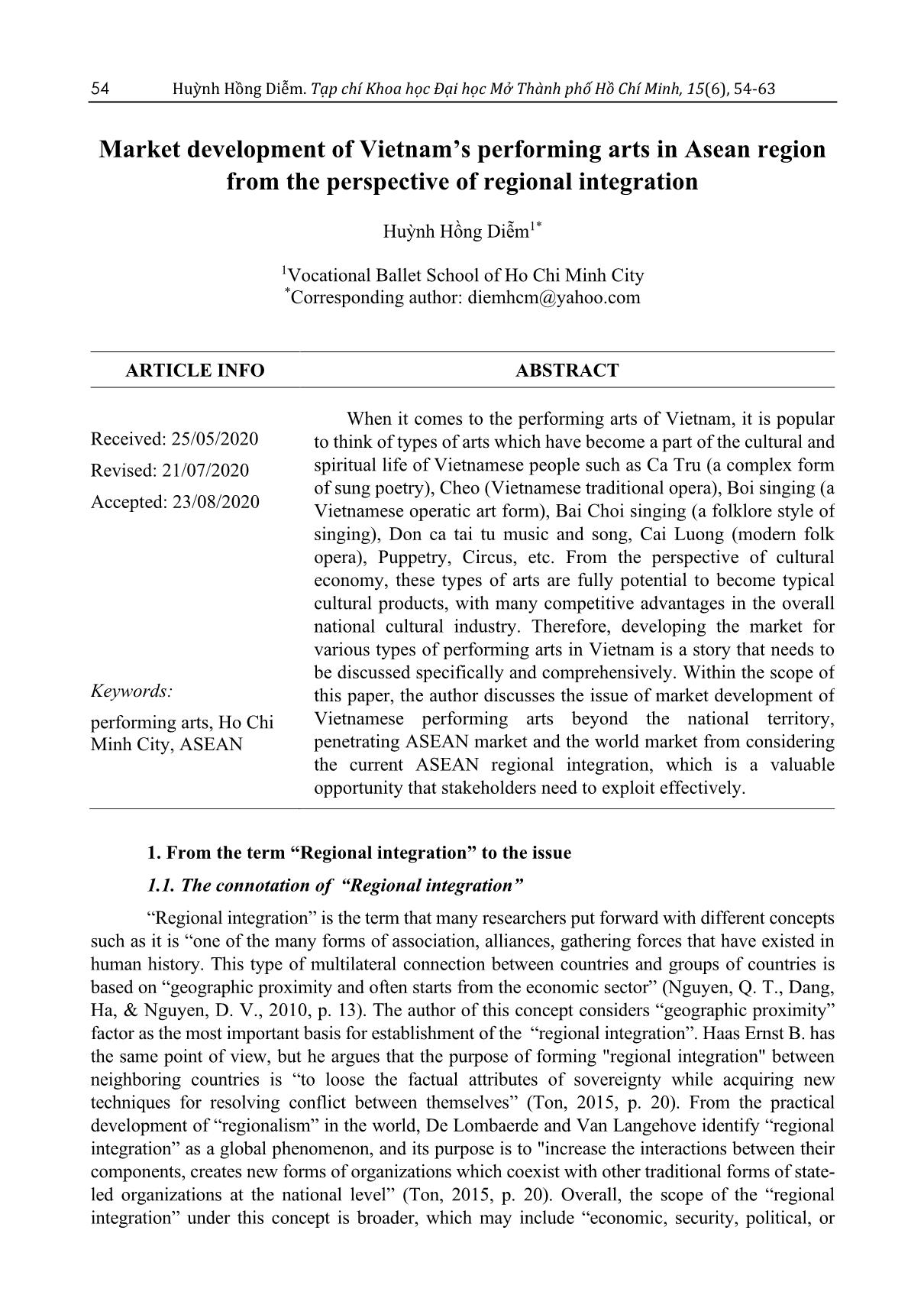
Trang 1
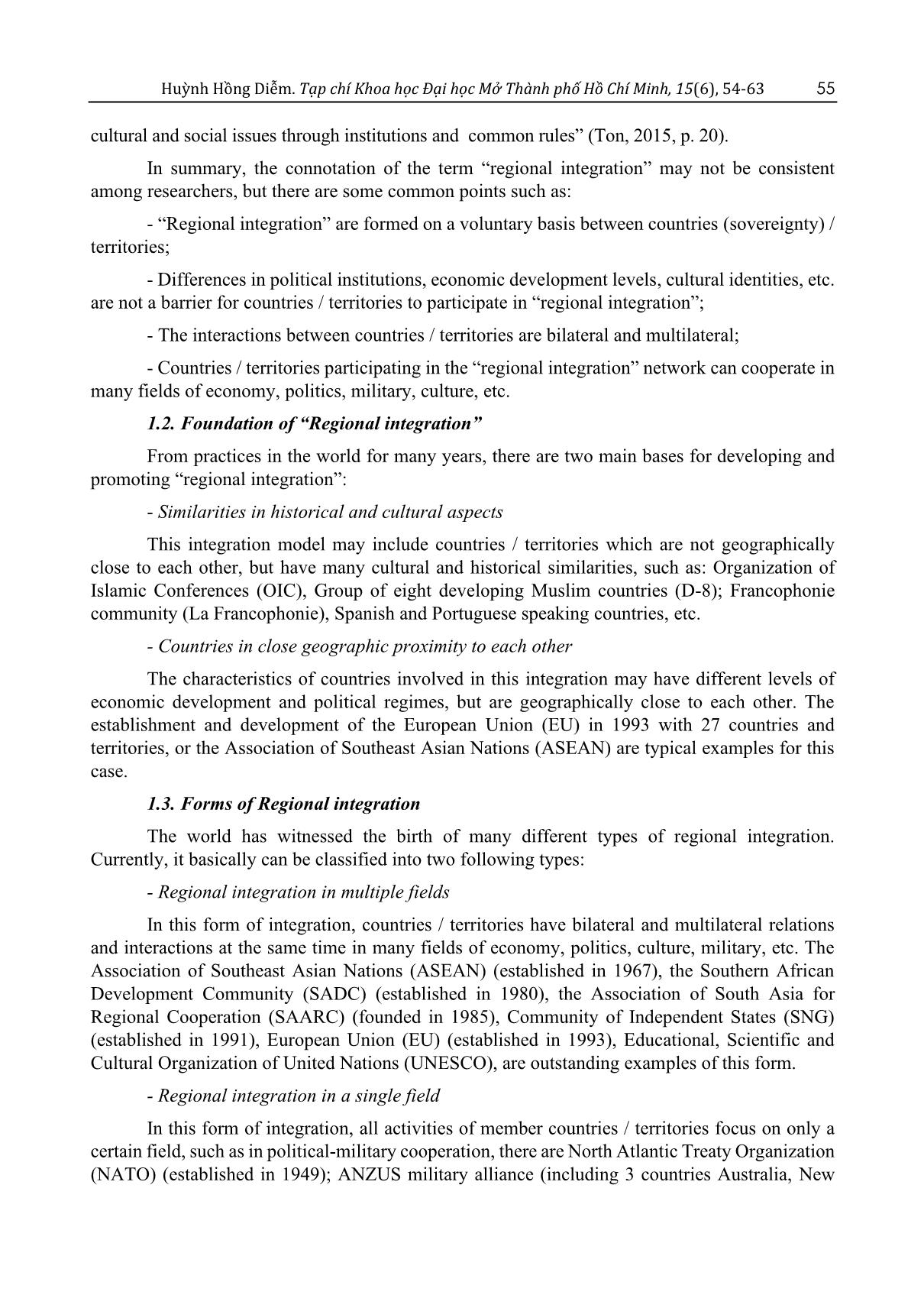
Trang 2
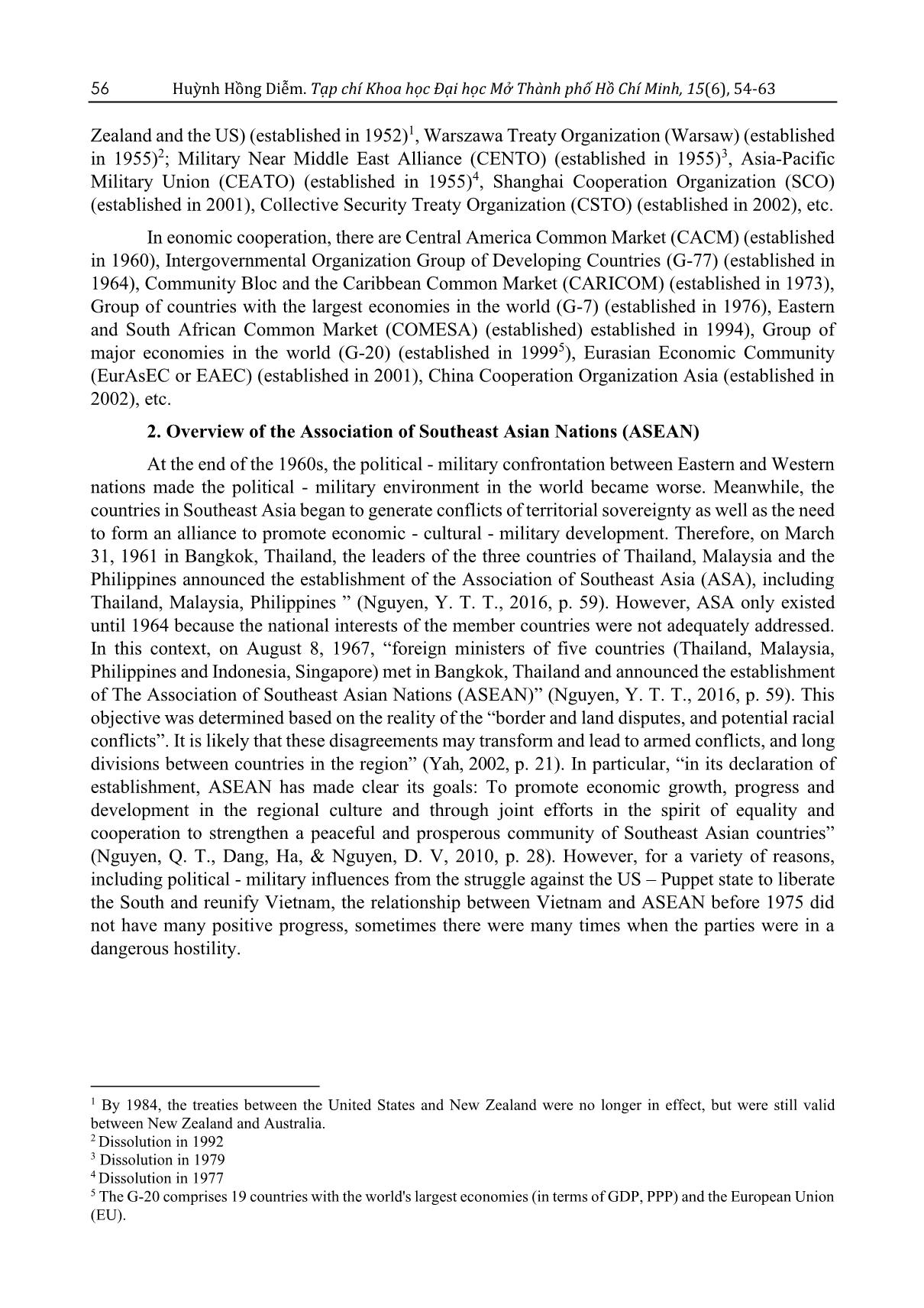
Trang 3
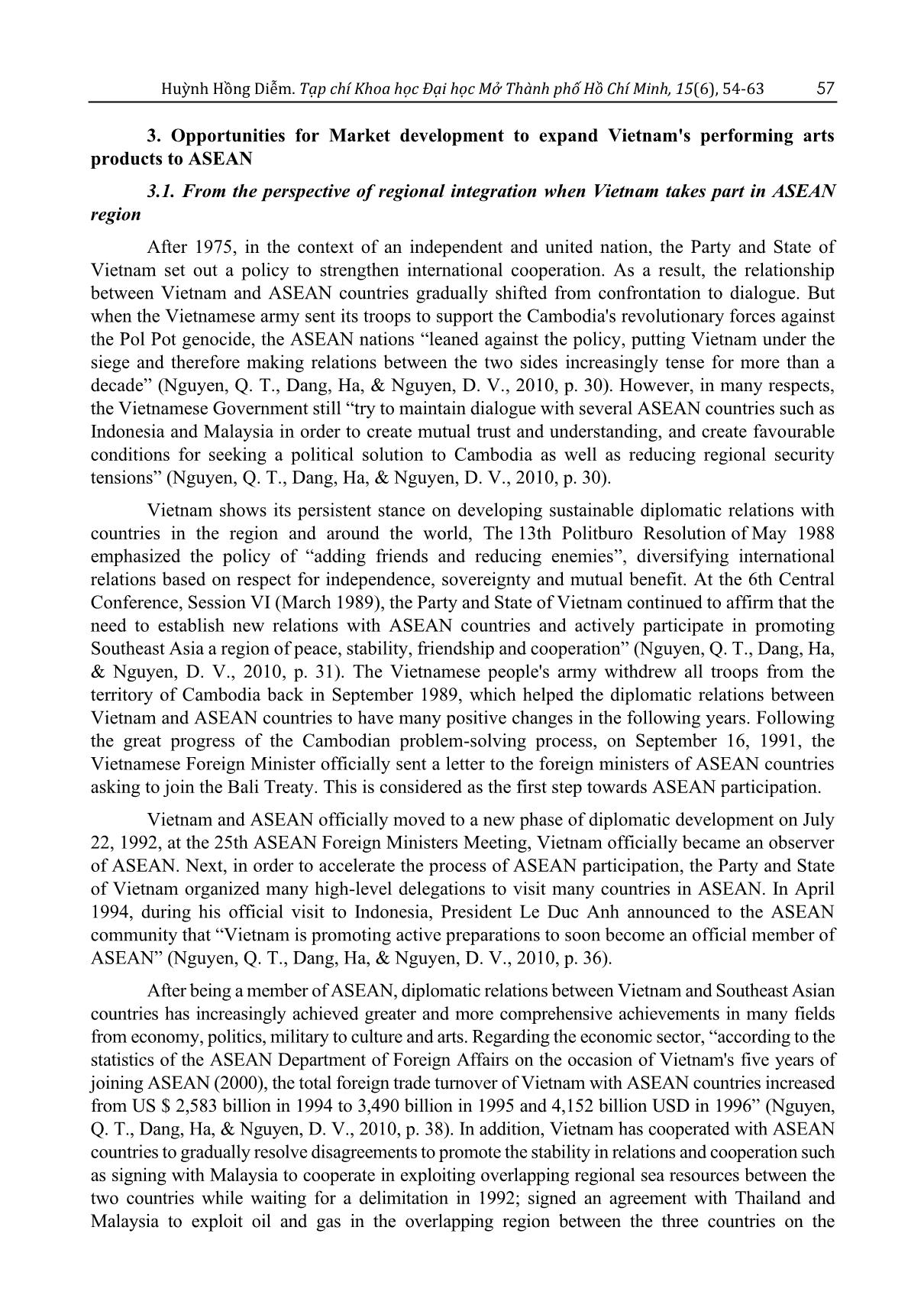
Trang 4
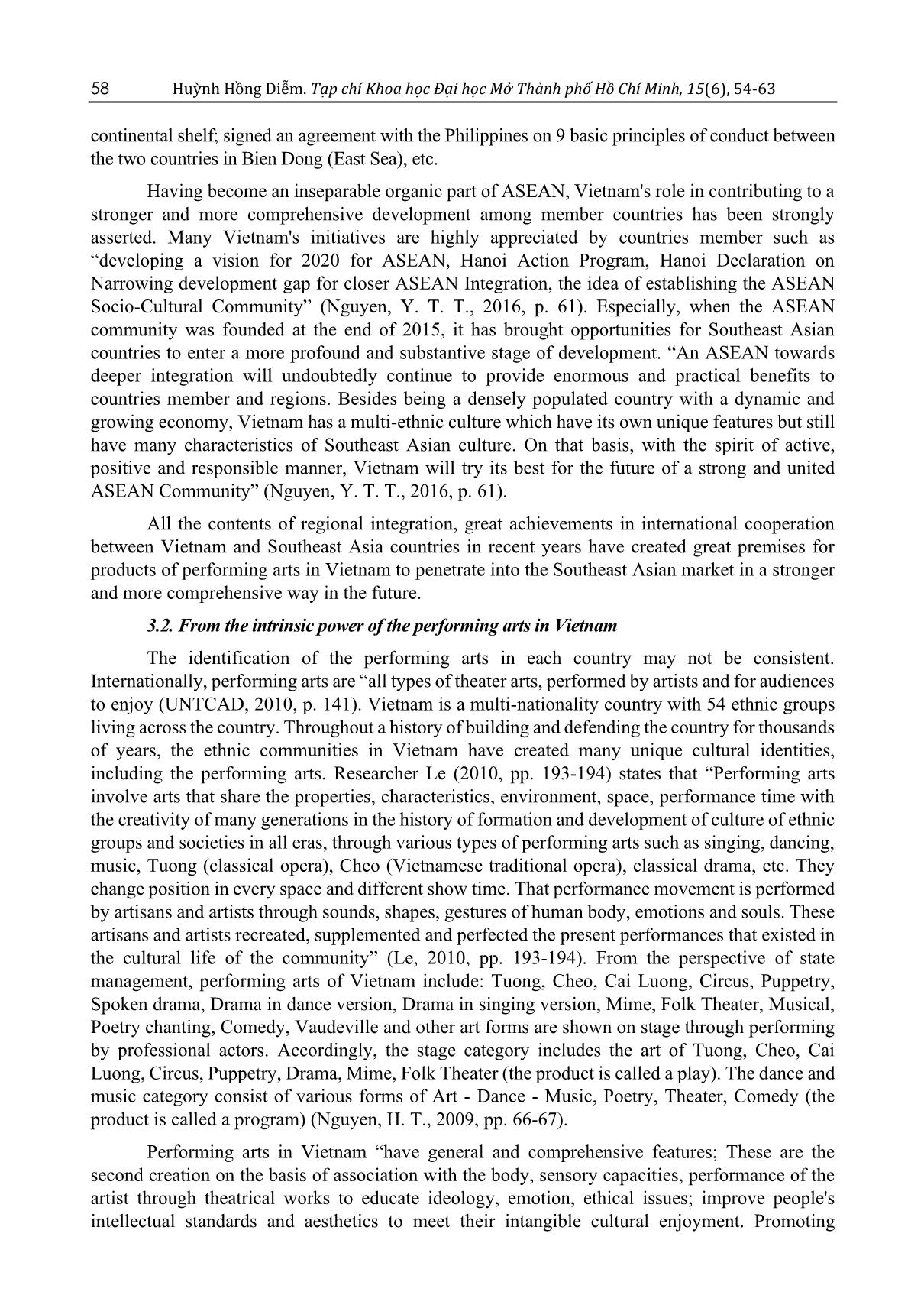
Trang 5
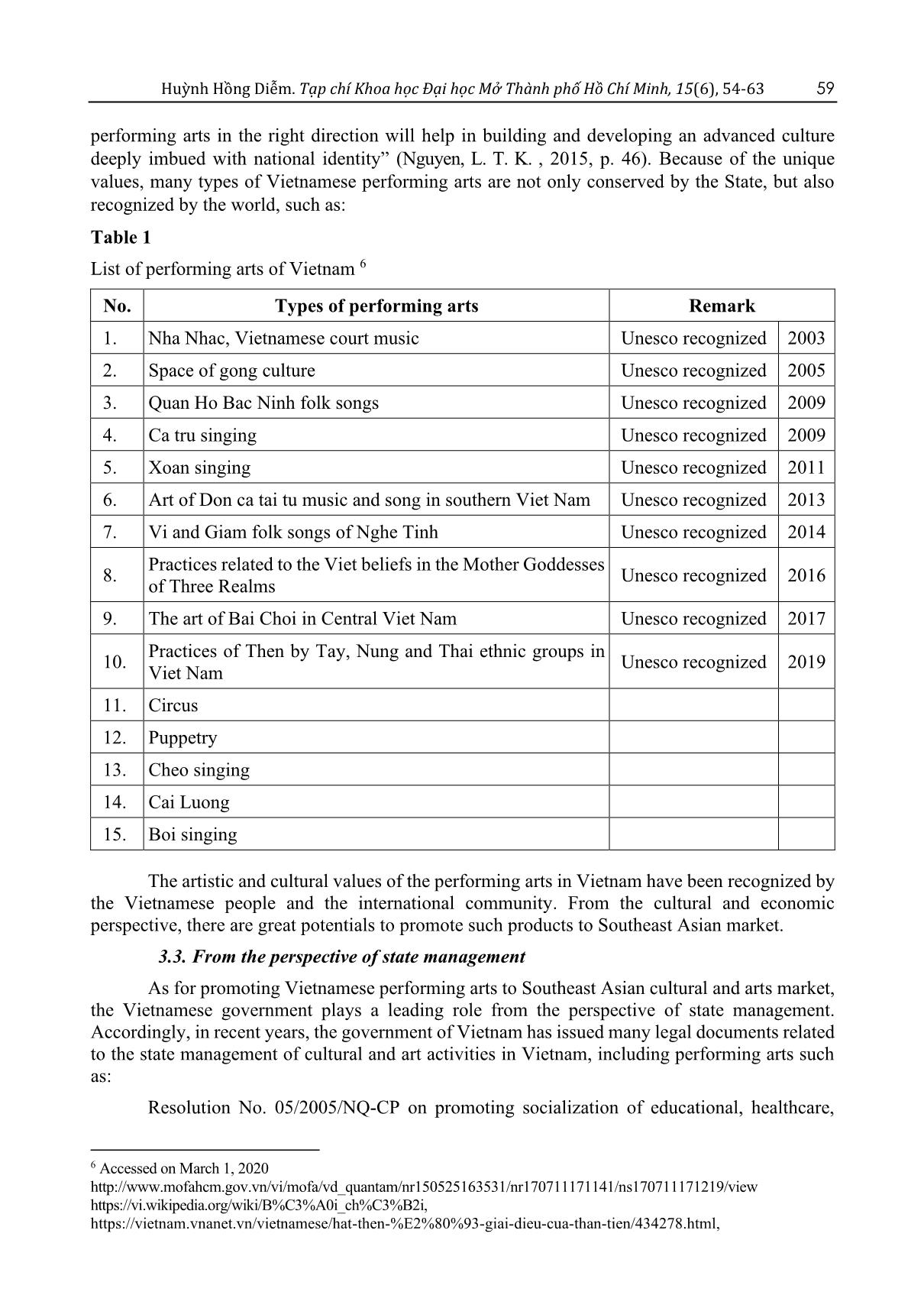
Trang 6
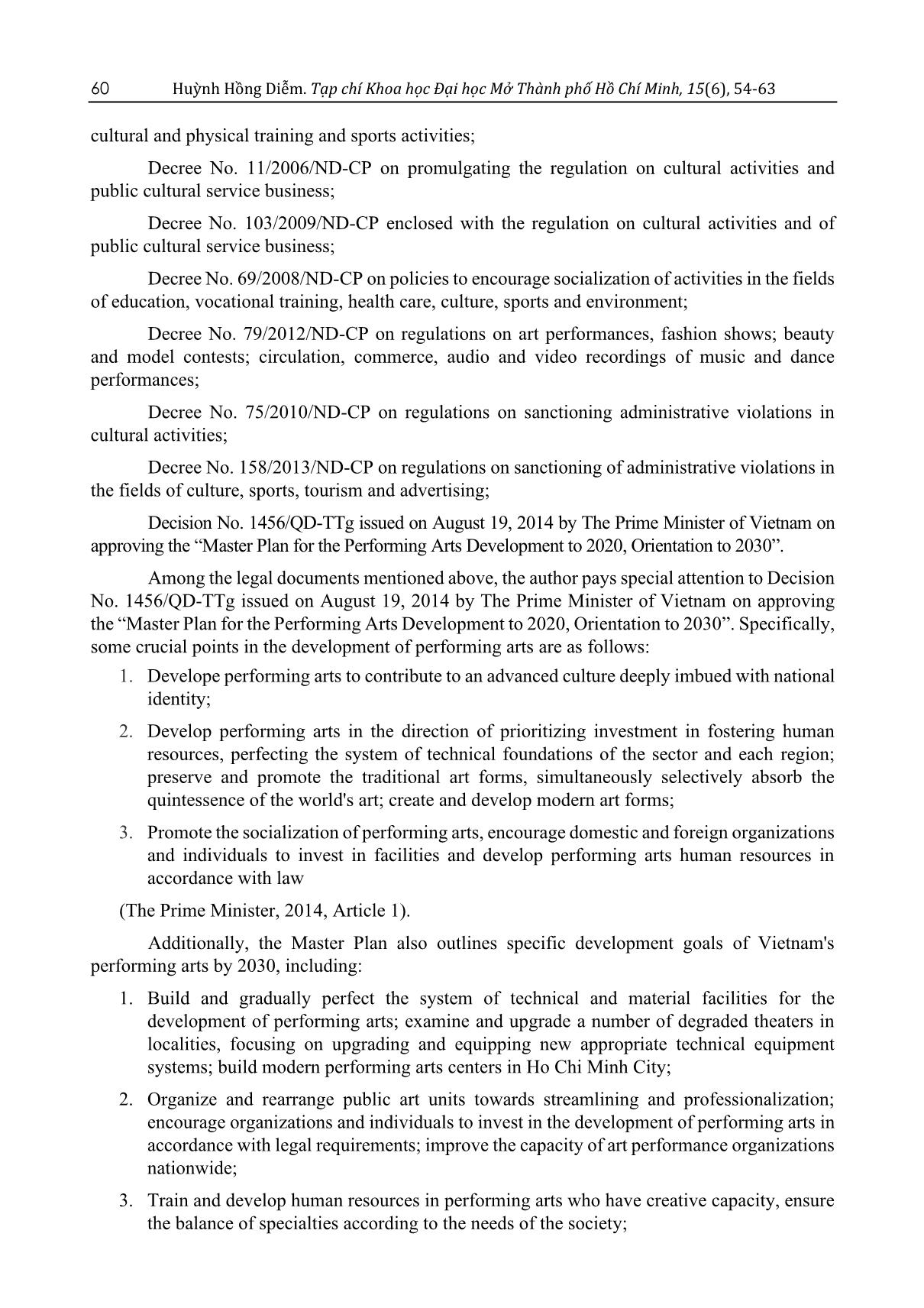
Trang 7
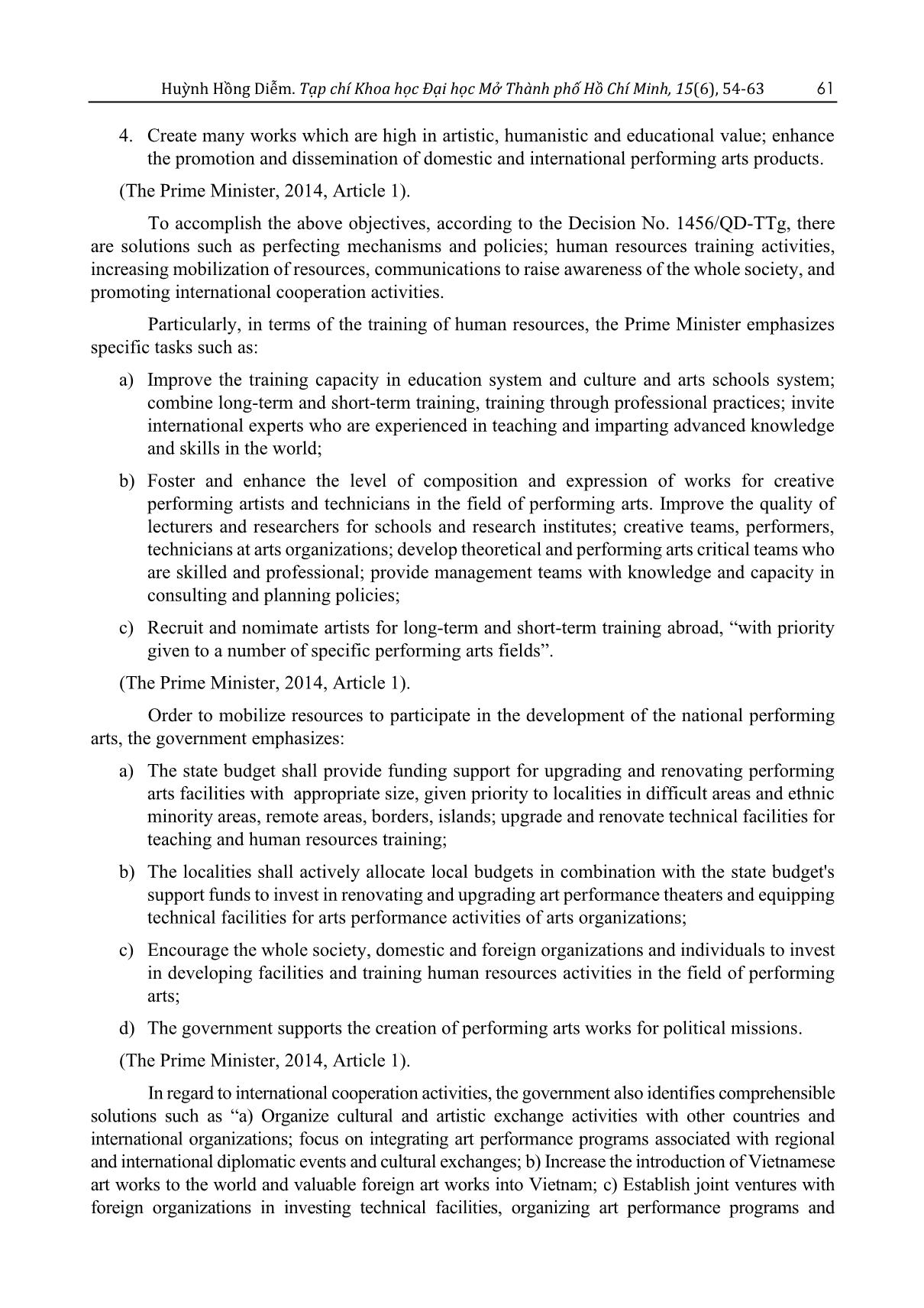
Trang 8
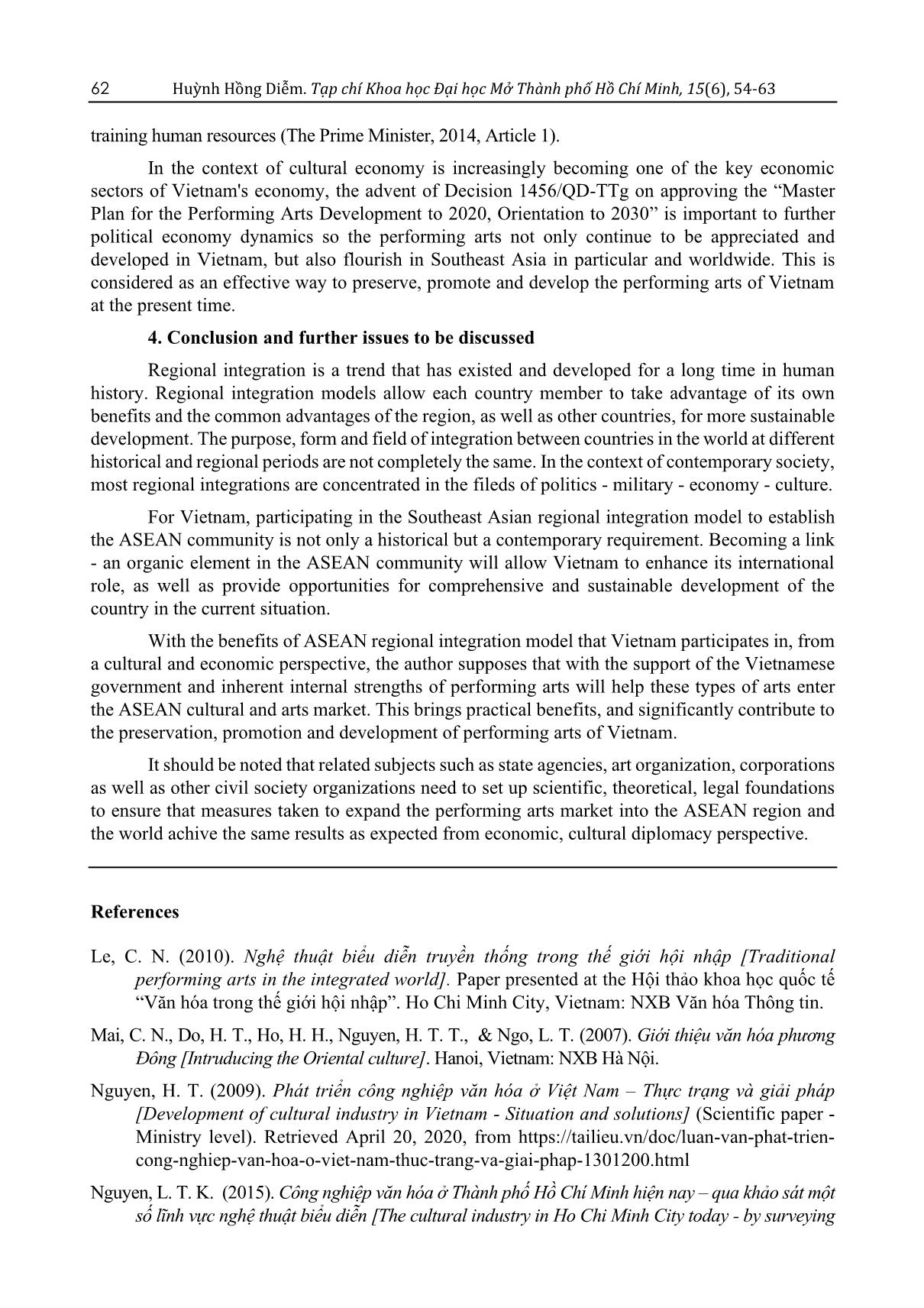
Trang 9
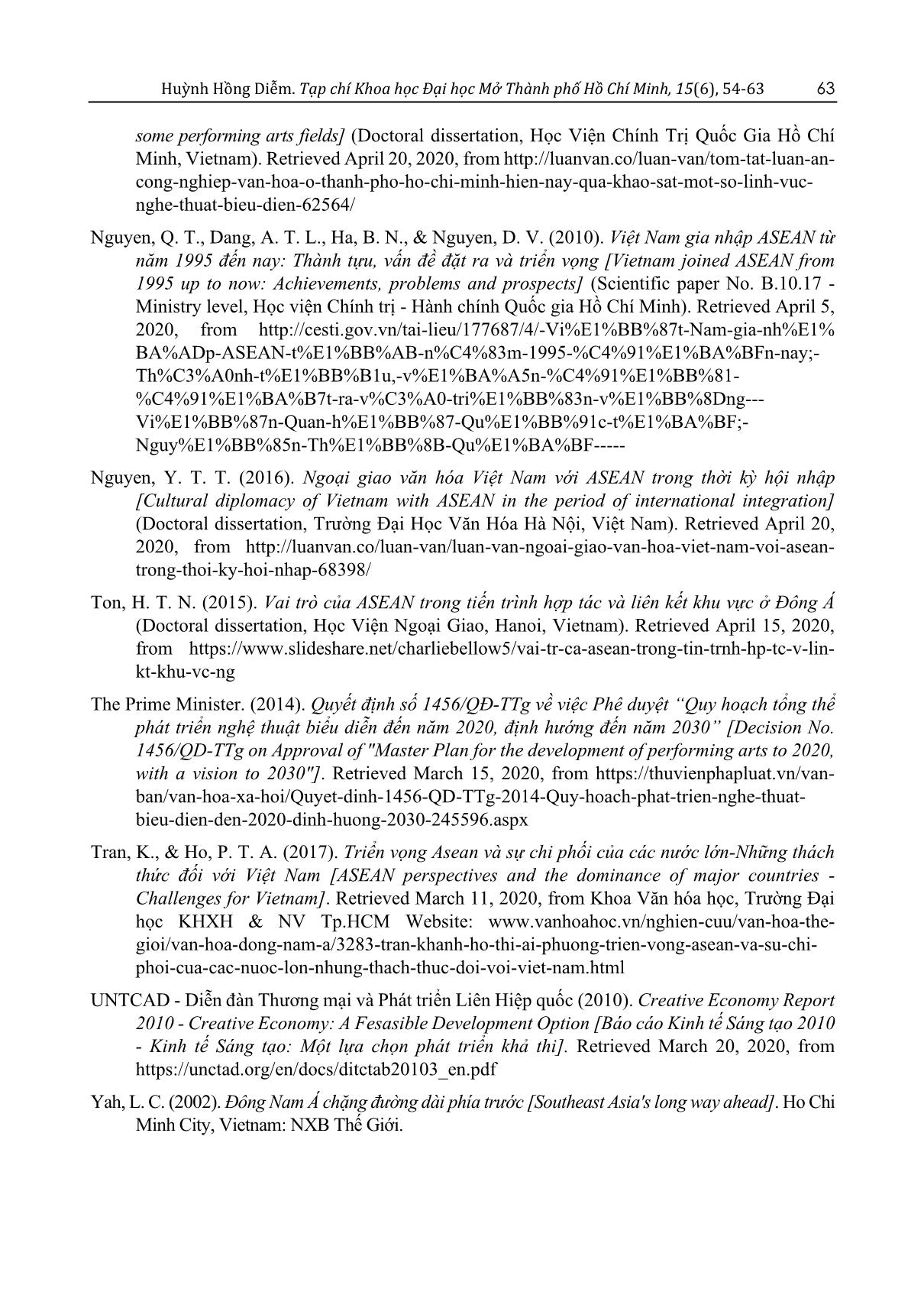
Trang 10
Tóm tắt nội dung tài liệu: Market development of Vietnam’s performing arts in Asean region from the perspective of regional integration
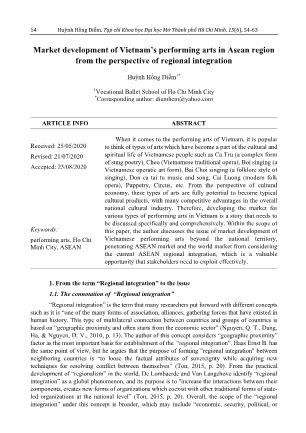
54 Huỳnh Hồng Diễm. Tạp chí Khoa học Đại học Mở Thành phố Hồ Chí Minh, 15(6), 54-63 Market development of Vietnam’s performing arts in Asean region from the perspective of regional integration Huỳnh Hồng Diễm1* 1Vocational Ballet School of Ho Chi Minh City *Corresponding author: diemhcm@yahoo.com ARTICLE INFO ABSTRACT When it comes to the performing arts of Vietnam, it is popular Received: 25/05/2020 to think of types of arts which have become a part of the cultural and Revised: 21/07/2020 spiritual life of Vietnamese people such as Ca Tru (a complex form of sung poetry), Cheo (Vietnamese traditional opera), Boi singing (a Accepted: 23/08/2020 Vietnamese operatic art form), Bai Choi singing (a folklore style of singing), Don ca tai tu music and song, Cai Luong (modern folk opera), Puppetry, Circus, etc. From the perspective of cultural economy, these types of arts are fully potential to become typical cultural products, with many competitive advantages in the overall national cultural industry. Therefore, developing the market for various types of performing arts in Vietnam is a story that needs to be discussed specifically and comprehensively. Within the scope of Keywords: this paper, the author discusses the issue of market development of performing arts, Ho Chi Vietnamese performing arts beyond the national territory, Minh City, ASEAN penetrating ASEAN market and the world market from considering the current ASEAN regional integration, which is a valuable opportunity that stakeholders need to exploit effectively. 1. From the term “Regional integration” to the issue 1.1. The connotation of “Regional integration” “Regional integration” is the term that many researchers put forward with different concepts such as it is “one of the many forms of association, alliances, gathering forces that have existed in human history. This type of multilateral connection between countries and groups of countries is based on “geographic proximity and often starts from the economic sector” (Nguyen, Q. T., Dang, Ha, & Nguyen, D. V., 2010, p. 13). The author of this concept considers “geographic proximity” factor as the most important basis for establishment of the “regional integration”. Haas Ernst B. has the same point of view, but he argues that the purpose of forming "regional integration" between neighboring countries is “to loose the factual attributes of sovereignty while acquiring new techniques for resolving conflict between themselves” (Ton, 2015, p. 20). From the practical development of “regionalism” in the world, De Lombaerde and Van Langehove identify “regional integration” as a global phenomenon, and its purpose is to "increase the interactions between their components, creates new forms of organizations which coexist with other traditional forms of state- led organizations at the national level” (Ton, 2015, p. 20). Overall, the scope of the “regional integration” under this concept is broader, which may include “economic, security, political, or Huỳnh Hồng Diễm. Tạp chí Khoa học Đại học Mở Thành phố Hồ Chí Minh, 15(6), 54-63 55 cultural and social issues through institutions and common rules” (Ton, 2015, p. 20). In summary, the connotation of the term “regional integration” may not be consistent among researchers, but there are some common points such as: - “Regional integration” are formed on a voluntary basis between countries (sovereignty) / territories; - Differences in political institutions, economic development levels, cultural identities, etc. are not a barrier for countries / territories to participate in “regional integration”; - The interactions between countries / territories are bilateral and multilateral; - Countries / territories participating in the “regional integration” network can cooperate in many fields of economy, politics, military, culture, etc. 1.2. Foundation of “Regional integration” From practices in the world for many years, there are two main bases for developing and promoting “regional integration”: - Similarities in historical and cultural aspects This integration model may include countries / territories which are not geographically close to each other, but have many cultural and historical similarities, such as: Organization of Islamic Conferences (OIC), Group of eight developing Muslim countries (D-8); Francophonie community (La Francophonie), Spanish and Portuguese speaking countries, etc. - Countries in close geographic proximity to each other The characteristics of countries involved in this integration may have different levels of economic development and political regimes, but are geographically close to each other. The establishment and development of the European Union (EU) in 1993 with 27 countries and territories, or the Association of Southeast Asian Nations (ASEAN) are typical examples for this case. 1.3. ... 5 3. Quan Ho Bac Ninh folk songs Unesco recognized 2009 4. Ca tru singing Unesco recognized 2009 5. Xoan singing Unesco recognized 2011 6. Art of Don ca tai tu music and song in southern Viet Nam Unesco recognized 2013 7. Vi and Giam folk songs of Nghe Tinh Unesco recognized 2014 Practices related to the Viet beliefs in the Mother Goddesses 8. Unesco recognized 2016 of Three Realms 9. The art of Bai Choi in Central Viet Nam Unesco recognized 2017 Practices of Then by Tay, Nung and Thai ethnic groups in 10. Unesco recognized 2019 Viet Nam 11. Circus 12. Puppetry 13. Cheo singing 14. Cai Luong 15. Boi singing The artistic and cultural values of the performing arts in Vietnam have been recognized by the Vietnamese people and the international community. From the cultural and economic perspective, there are great potentials to promote such products to Southeast Asian market. 3.3. From the perspective of state management As for promoting Vietnamese performing arts to Southeast Asian cultural and arts market, the Vietnamese government plays a leading role from the perspective of state management. Accordingly, in recent years, the government of Vietnam has issued many legal documents related to the state management of cultural and art activities in Vietnam, including performing arts such as: Resolution No. 05/2005/NQ-CP on promoting socialization of educational, healthcare, 6 Accessed on March 1, 2020 https://vi.wikipedia.org/wiki/B%C3%A0i_ch%C3%B2i, https://vietnam.vnanet.vn/vietnamese/hat-then-%E2%80%93-giai-dieu-cua-than-tien/434278.html, 60 Huỳnh Hồng Diễm. Tạp chí Khoa học Đại học Mở Thành phố Hồ Chí Minh, 15(6), 54-63 cultural and physical training and sports activities; Decree No. 11/2006/ND-CP on promulgating the regulation on cultural activities and public cultural service business; Decree No. 103/2009/ND-CP enclosed with the regulation on cultural activities and of public cultural service business; Decree No. 69/2008/ND-CP on policies to encourage socialization of activities in the fields of education, vocational training, health care, culture, sports and environment; Decree No. 79/2012/ND-CP on regulations on art performances, fashion shows; beauty and model contests; circulation, commerce, audio and video recordings of music and dance performances; Decree No. 75/2010/ND-CP on regulations on sanctioning administrative violations in cultural activities; Decree No. 158/2013/ND-CP on regulations on sanctioning of administrative violations in the fields of culture, sports, tourism and advertising; Decision No. 1456/QD-TTg issued on August 19, 2014 by The Prime Minister of Vietnam on approving the “Master Plan for the Performing Arts Development to 2020, Orientation to 2030”. Among the legal documents mentioned above, the author pays special attention to Decision No. 1456/QD-TTg issued on August 19, 2014 by The Prime Minister of Vietnam on approving the “Master Plan for the Performing Arts Development to 2020, Orientation to 2030”. Specifically, some crucial points in the development of performing arts are as follows: 1. Develope performing arts to contribute to an advanced culture deeply imbued with national identity; 2. Develop performing arts in the direction of prioritizing investment in fostering human resources, perfecting the system of technical foundations of the sector and each region; preserve and promote the traditional art forms, simultaneously selectively absorb the quintessence of the world's art; create and develop modern art forms; 3. Promote the socialization of performing arts, encourage domestic and foreign organizations and individuals to invest in facilities and develop performing arts human resources in accordance with law (The Prime Minister, 2014, Article 1). Additionally, the Master Plan also outlines specific development goals of Vietnam's performing arts by 2030, including: 1. Build and gradually perfect the system of technical and material facilities for the development of performing arts; examine and upgrade a number of degraded theaters in localities, focusing on upgrading and equipping new appropriate technical equipment systems; build modern performing arts centers in Ho Chi Minh City; 2. Organize and rearrange public art units towards streamlining and professionalization; encourage organizations and individuals to invest in the development of performing arts in accordance with legal requirements; improve the capacity of art performance organizations nationwide; 3. Train and develop human resources in performing arts who have creative capacity, ensure the balance of specialties according to the needs of the society; Huỳnh Hồng Diễm. Tạp chí Khoa học Đại học Mở Thành phố Hồ Chí Minh, 15(6), 54-63 61 4. Create many works which are high in artistic, humanistic and educational value; enhance the promotion and dissemination of domestic and international performing arts products. (The Prime Minister, 2014, Article 1). To accomplish the above objectives, according to the Decision No. 1456/QD-TTg, there are solutions such as perfecting mechanisms and policies; human resources training activities, increasing mobilization of resources, communications to raise awareness of the whole society, and promoting international cooperation activities. Particularly, in terms of the training of human resources, the Prime Minister emphasizes specific tasks such as: a) Improve the training capacity in education system and culture and arts schools system; combine long-term and short-term training, training through professional practices; invite international experts who are experienced in teaching and imparting advanced knowledge and skills in the world; b) Foster and enhance the level of composition and expression of works for creative performing artists and technicians in the field of performing arts. Improve the quality of lecturers and researchers for schools and research institutes; creative teams, performers, technicians at arts organizations; develop theoretical and performing arts critical teams who are skilled and professional; provide management teams with knowledge and capacity in consulting and planning policies; c) Recruit and nomimate artists for long-term and short-term training abroad, “with priority given to a number of specific performing arts fields”. (The Prime Minister, 2014, Article 1). Order to mobilize resources to participate in the development of the national performing arts, the government emphasizes: a) The state budget shall provide funding support for upgrading and renovating performing arts facilities with appropriate size, given priority to localities in difficult areas and ethnic minority areas, remote areas, borders, islands; upgrade and renovate technical facilities for teaching and human resources training; b) The localities shall actively allocate local budgets in combination with the state budget's support funds to invest in renovating and upgrading art performance theaters and equipping technical facilities for arts performance activities of arts organizations; c) Encourage the whole society, domestic and foreign organizations and individuals to invest in developing facilities and training human resources activities in the field of performing arts; d) The government supports the creation of performing arts works for political missions. (The Prime Minister, 2014, Article 1). In regard to international cooperation activities, the government also identifies comprehensible solutions such as “a) Organize cultural and artistic exchange activities with other countries and international organizations; focus on integrating art performance programs associated with regional and international diplomatic events and cultural exchanges; b) Increase the introduction of Vietnamese art works to the world and valuable foreign art works into Vietnam; c) Establish joint ventures with foreign organizations in investing technical facilities, organizing art performance programs and 62 Huỳnh Hồng Diễm. Tạp chí Khoa học Đại học Mở Thành phố Hồ Chí Minh, 15(6), 54-63 training human resources (The Prime Minister, 2014, Article 1). In the context of cultural economy is increasingly becoming one of the key economic sectors of Vietnam's economy, the advent of Decision 1456/QD-TTg on approving the “Master Plan for the Performing Arts Development to 2020, Orientation to 2030” is important to further political economy dynamics so the performing arts not only continue to be appreciated and developed in Vietnam, but also flourish in Southeast Asia in particular and worldwide. This is considered as an effective way to preserve, promote and develop the performing arts of Vietnam at the present time. 4. Conclusion and further issues to be discussed Regional integration is a trend that has existed and developed for a long time in human history. Regional integration models allow each country member to take advantage of its own benefits and the common advantages of the region, as well as other countries, for more sustainable development. The purpose, form and field of integration between countries in the world at different historical and regional periods are not completely the same. In the context of contemporary society, most regional integrations are concentrated in the fileds of politics - military - economy - culture. For Vietnam, participating in the Southeast Asian regional integration model to establish the ASEAN community is not only a historical but a contemporary requirement. Becoming a link - an organic element in the ASEAN community will allow Vietnam to enhance its international role, as well as provide opportunities for comprehensive and sustainable development of the country in the current situation. With the benefits of ASEAN regional integration model that Vietnam participates in, from a cultural and economic perspective, the author supposes that with the support of the Vietnamese government and inherent internal strengths of performing arts will help these types of arts enter the ASEAN cultural and arts market. This brings practical benefits, and significantly contribute to the preservation, promotion and development of performing arts of Vietnam. It should be noted that related subjects such as state agencies, art organization, corporations as well as other civil society organizations need to set up scientific, theoretical, legal foundations to ensure that measures taken to expand the performing arts market into the ASEAN region and the world achive the same results as expected from economic, cultural diplomacy perspective. References Le, C. N. (2010). Nghệ thuật biểu diễn truyền thống trong thế giới hội nhập [Traditional performing arts in the integrated world]. Paper presented at the Hội thảo khoa học quốc tế “Văn hóa trong thế giới hội nhập”. Ho Chi Minh City, Vietnam: NXB Văn hóa Thông tin. Mai, C. N., Do, H. T., Ho, H. H., Nguyen, H. T. T., & Ngo, L. T. (2007). Giới thiệu văn hóa phương Đông [Intruducing the Oriental culture]. Hanoi, Vietnam: NXB Hà Nội. Nguyen, H. T. (2009). Phát triển công nghiệp văn hóa ở Việt Nam – Thực trạng và giải pháp [Development of cultural industry in Vietnam - Situation and solutions] (Scientific paper - Ministry level). Retrieved April 20, 2020, from https://tailieu.vn/doc/luan-van-phat-trien- cong-nghiep-van-hoa-o-viet-nam-thuc-trang-va-giai-phap-1301200.html Nguyen, L. T. K. (2015). Công nghiệp văn hóa ở Thành phố Hồ Chí Minh hiện nay – qua khảo sát một số lĩnh vực nghệ thuật biểu diễn [The cultural industry in Ho Chi Minh City today - by surveying Huỳnh Hồng Diễm. Tạp chí Khoa học Đại học Mở Thành phố Hồ Chí Minh, 15(6), 54-63 63 some performing arts fields] (Doctoral dissertation, Học Viện Chính Trị Quốc Gia Hồ Chí Minh, Vietnam). Retrieved April 20, 2020, from cong-nghiep-van-hoa-o-thanh-pho-ho-chi-minh-hien-nay-qua-khao-sat-mot-so-linh-vuc- nghe-thuat-bieu-dien-62564/ Nguyen, Q. T., Dang, A. T. L., Ha, B. N., & Nguyen, D. V. (2010). Việt Nam gia nhập ASEAN từ năm 1995 đến nay: Thành tựu, vấn đề đặt ra và triển vọng [Vietnam joined ASEAN from 1995 up to now: Achievements, problems and prospects] (Scientific paper No. B.10.17 - Ministry level, Học viện Chính trị - Hành chính Quốc gia Hồ Chí Minh). Retrieved April 5, 2020, from BA%ADp-ASEAN-t%E1%BB%AB-n%C4%83m-1995-%C4%91%E1%BA%BFn-nay;- Th%C3%A0nh-t%E1%BB%B1u,-v%E1%BA%A5n-%C4%91%E1%BB%81- %C4%91%E1%BA%B7t-ra-v%C3%A0-tri%E1%BB%83n-v%E1%BB%8Dng--- Vi%E1%BB%87n-Quan-h%E1%BB%87-Qu%E1%BB%91c-t%E1%BA%BF;- Nguy%E1%BB%85n-Th%E1%BB%8B-Qu%E1%BA%BF----- Nguyen, Y. T. T. (2016). Ngoại giao văn hóa Việt Nam với ASEAN trong thời kỳ hội nhập [Cultural diplomacy of Vietnam with ASEAN in the period of international integration] (Doctoral dissertation, Trường Đại Học Văn Hóa Hà Nội, Việt Nam). Retrieved April 20, 2020, from trong-thoi-ky-hoi-nhap-68398/ Ton, H. T. N. (2015). Vai trò của ASEAN trong tiến trình hợp tác và liên kết khu vực ở Đông Á (Doctoral dissertation, Học Viện Ngoại Giao, Hanoi, Vietnam). Retrieved April 15, 2020, from https://www.slideshare.net/charliebellow5/vai-tr-ca-asean-trong-tin-trnh-hp-tc-v-lin- kt-khu-vc-ng The Prime Minister. (2014). Quyết định số 1456/QĐ-TTg về việc Phê duyệt “Quy hoạch tổng thể phát triển nghệ thuật biểu diễn đến năm 2020, định hướng đến năm 2030” [Decision No. 1456/QD-TTg on Approval of "Master Plan for the development of performing arts to 2020, with a vision to 2030"]. Retrieved March 15, 2020, from https://thuvienphapluat.vn/van- ban/van-hoa-xa-hoi/Quyet-dinh-1456-QD-TTg-2014-Quy-hoach-phat-trien-nghe-thuat- bieu-dien-den-2020-dinh-huong-2030-245596.aspx Tran, K., & Ho, P. T. A. (2017). Triển vọng Asean và sự chi phối của các nước lớn-Những thách thức đối với Việt Nam [ASEAN perspectives and the dominance of major countries - Challenges for Vietnam]. Retrieved March 11, 2020, from Khoa Văn hóa học, Trường Đại học KHXH & NV Tp.HCM Website: www.vanhoahoc.vn/nghien-cuu/van-hoa-the- gioi/van-hoa-dong-nam-a/3283-tran-khanh-ho-thi-ai-phuong-trien-vong-asean-va-su-chi- phoi-cua-cac-nuoc-lon-nhung-thach-thuc-doi-voi-viet-nam.html UNTCAD - Diễn đàn Thương mại và Phát triển Liên Hiệp quốc (2010). Creative Economy Report 2010 - Creative Economy: A Fesasible Development Option [Báo cáo Kinh tế Sáng tạo 2010 - Kinh tế Sáng tạo: Một lựa chọn phát triển khả thi]. Retrieved March 20, 2020, from https://unctad.org/en/docs/ditctab20103_en.pdf Yah, L. C. (2002). Đông Nam Á chặng đường dài phía trước [Southeast Asia's long way ahead]. Ho Chi Minh City, Vietnam: NXB Thế Giới.
File đính kèm:
 market_development_of_vietnams_performing_arts_in_asean_regi.pdf
market_development_of_vietnams_performing_arts_in_asean_regi.pdf

